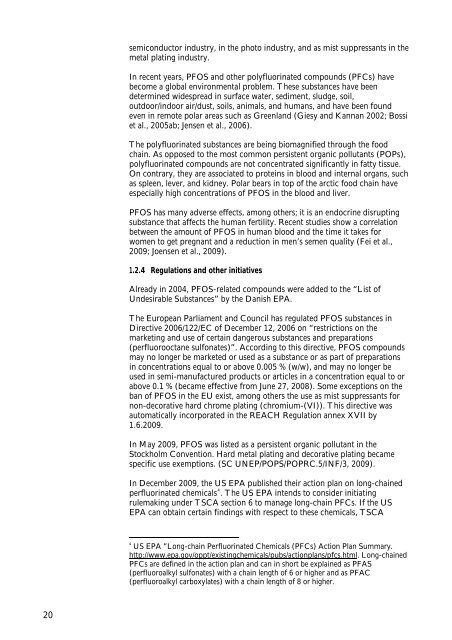Substitution of PFOS for use in nondecorative hard chrome plating
Substitution of PFOS for use in nondecorative hard chrome plating
Substitution of PFOS for use in nondecorative hard chrome plating
You also want an ePaper? Increase the reach of your titles
YUMPU automatically turns print PDFs into web optimized ePapers that Google loves.
20<br />
semiconductor <strong>in</strong>dustry, <strong>in</strong> the photo <strong>in</strong>dustry, and as mist suppressants <strong>in</strong> the<br />
metal plat<strong>in</strong>g <strong>in</strong>dustry.<br />
In recent years, <strong>PFOS</strong> and other polyfluor<strong>in</strong>ated compounds (PFCs) have<br />
become a global environmental problem. These substances have been<br />
determ<strong>in</strong>ed widespread <strong>in</strong> surface water, sediment, sludge, soil,<br />
outdoor/<strong>in</strong>door air/dust, soils, animals, and humans, and have been found<br />
even <strong>in</strong> remote polar areas such as Greenland (Giesy and Kannan 2002; Bossi<br />
et al., 2005ab; Jensen et al., 2006).<br />
The polyfluor<strong>in</strong>ated substances are be<strong>in</strong>g biomagnified through the food<br />
cha<strong>in</strong>. As opposed to the most common persistent organic pollutants (POPs),<br />
polyfluor<strong>in</strong>ated compounds are not concentrated significantly <strong>in</strong> fatty tissue.<br />
On contrary, they are associated to prote<strong>in</strong>s <strong>in</strong> blood and <strong>in</strong>ternal organs, such<br />
as spleen, lever, and kidney. Polar bears <strong>in</strong> top <strong>of</strong> the arctic food cha<strong>in</strong> have<br />
especially high concentrations <strong>of</strong> <strong>PFOS</strong> <strong>in</strong> the blood and liver.<br />
<strong>PFOS</strong> has many adverse effects, among others; it is an endocr<strong>in</strong>e disrupt<strong>in</strong>g<br />
substance that affects the human fertility. Recent studies show a correlation<br />
between the amount <strong>of</strong> <strong>PFOS</strong> <strong>in</strong> human blood and the time it takes <strong>for</strong><br />
women to get pregnant and a reduction <strong>in</strong> men’s semen quality (Fei et al.,<br />
2009; Joensen et al., 2009).<br />
1.2.4 Regulations and other <strong>in</strong>itiatives<br />
Already <strong>in</strong> 2004, <strong>PFOS</strong>-related compounds were added to the “List <strong>of</strong><br />
Undesirable Substances” by the Danish EPA.<br />
The European Parliament and Council has regulated <strong>PFOS</strong> substances <strong>in</strong><br />
Directive 2006/122/EC <strong>of</strong> December 12, 2006 on “restrictions on the<br />
market<strong>in</strong>g and <strong>use</strong> <strong>of</strong> certa<strong>in</strong> dangerous substances and preparations<br />
(perfluorooctane sulfonates)”. Accord<strong>in</strong>g to this directive, <strong>PFOS</strong> compounds<br />
may no longer be marketed or <strong>use</strong>d as a substance or as part <strong>of</strong> preparations<br />
<strong>in</strong> concentrations equal to or above 0.005 % (w/w), and may no longer be<br />
<strong>use</strong>d <strong>in</strong> semi-manufactured products or articles <strong>in</strong> a concentration equal to or<br />
above 0.1 % (became effective from June 27, 2008). Some exceptions on the<br />
ban <strong>of</strong> <strong>PFOS</strong> <strong>in</strong> the EU exist, among others the <strong>use</strong> as mist suppressants <strong>for</strong><br />
non-decorative <strong>hard</strong> <strong>chrome</strong> plat<strong>in</strong>g (chromium-(VI)). This directive was<br />
automatically <strong>in</strong>corporated <strong>in</strong> the REACH Regulation annex XVII by<br />
1.6.2009.<br />
In May 2009, <strong>PFOS</strong> was listed as a persistent organic pollutant <strong>in</strong> the<br />
Stockholm Convention. Hard metal plat<strong>in</strong>g and decorative plat<strong>in</strong>g became<br />
specific <strong>use</strong> exemptions. (SC UNEP/POPS/POPRC.5/INF/3, 2009).<br />
In December 2009, the US EPA published their action plan on long-cha<strong>in</strong>ed<br />
perfluor<strong>in</strong>ated chemicals 4<br />
. The US EPA <strong>in</strong>tends to consider <strong>in</strong>itiat<strong>in</strong>g<br />
rulemak<strong>in</strong>g under TSCA section 6 to manage long-cha<strong>in</strong> PFCs. If the US<br />
EPA can obta<strong>in</strong> certa<strong>in</strong> f<strong>in</strong>d<strong>in</strong>gs with respect to these chemicals, TSCA<br />
4 US EPA ”Long-cha<strong>in</strong> Perfluor<strong>in</strong>ated Chemicals (PFCs) Action Plan Summary.<br />
http://www.epa.gov/oppt/exist<strong>in</strong>gchemicals/pubs/actionplans/pfcs.html. Long-cha<strong>in</strong>ed<br />
PFCs are def<strong>in</strong>ed <strong>in</strong> the action plan and can <strong>in</strong> short be expla<strong>in</strong>ed as PFAS<br />
(perfluoroalkyl sulfonates) with a cha<strong>in</strong> length <strong>of</strong> 6 or higher and as PFAC<br />
(perfluoroalkyl carboxylates) with a cha<strong>in</strong> length <strong>of</strong> 8 or higher.

















